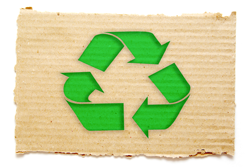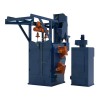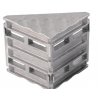
Exhibitions used to be highly wasteful and environmentally unfriendly. But all that is changing. Rachel Miller reveals how to make your exhibition stand more sustainable
Exhibitions, by their very nature, are not the most eco-friendly of marketing activities. Bringing all those exhibitors, stands and visitors together in one place involves an awful lot of travelling to start with.
However, exhibitions are becoming much more sustainable thanks to the efforts of the show venues and forward-thinking stand design companies. “In the past, exhibitions have been completely wasteful,” says Peter Forse, director of stand design specialists, Apex. “When you went to a big venue before or after a show, the thing that struck you straight away was the amount of waste. In the past, all the packaging, such as bubble wrap and cardboard was thrown into a general purpose skip. Now venues supply different skips for different materials.”
The acres of carpet that are put down on stand floors and in aisles are more likely to be recycled these days, too. “Venues typically use a type of cord carpet which is thin and is designed to be used for a few days and then thrown away,” explains Forse. “Now, people have woken up to the fact that carpet can be recycled. Also, some shows have got rid of carpets altogether and simply paint the concrete floor.”
Modular approach to exhibition stands
But perhaps the biggest change of all is that most stands are now built to last. In the past, it was not uncommon for companies to build bespoke stands that were only designed for one event. The whole lot would end up in a skip after the show.
“Companies have moved towards more reusable stands,” says Forse. “Custom-build has not totally disappeared but modular stands are much more common. Even those using custom-build designs don’t throw them away after one use anymore, they tend to design them for a programme of events.”
Modular stand systems are not just more environmentally-friendly, they can be easier and cheaper to store and transport. “Modular stands have come on in leaps and bounds,” says Forse. “Before they were seen as too boxy and not creative enough. Now they are much more up-to-date and offer interesting features. It’s more common now to use a modular base and add some customised features - that’s something we do for a lot of clients.”
Cutting down on printed materials
Marketing techniques are changing, too. The days when companies printed and distributed thousands of brochures are long gone. Today, you are more likely to use a brief marketing flyer with a scannable QR code which will take exhibition attendees to your online marketing material, give out a CD or take a potential customer's email address so you can email relevant marketing material to them after the event. If companies do have brochures, they often post them to prospects after the show rather than hand them out in huge numbers. Contacting prospects via email or post soon after the event can be an effective next step in your sales process.
However, while many exhibitors are committed to sustainability they don’t want to make creative compromises when it comes to their stand. There’s no need to compromise, says Forse. “One of the greenest materials is aluminium. Our new Custom Modular aluminium profile system, for example, has the benefits of a custom design with the flexibility and value of a modular stand. And, even after many years of use, the aluminium is 100 per cent recyclable. In fact, aluminium can be recycled an infinite number of times with no loss of quality.”
Many stand designers, like Apex, are taking the initiative themselves on sustainability. “We aim to be more efficient in our use of materials and recycle more things more often. This helps to minimise landfill, reduce carbon emissions and improve our environment,” says Forse.
Finally, when you are exhibiting, it’s worth promoting your green credentials. It helps to spread the word about sustainability and it could be good for business.
Ten ways to make your exhibition stand more sustainable
Choose a long-lasting modular stand.
Re-use any bespoke elements.
Lay fibre mixed carpets that can be recycled and turned into wheelie bins and plant pots. Or put down carpet tiles that can be re-used.
Choose materials that can be recycled: cardboard panels; plastic sheets for worktops.
Use timber from well-managed forests (with Forest Stewarding Council approval).
Install low wattage lighting or LED energy efficient lighting.
Use volatile organic compound-free adhesives.
Look for “green” water-based paints.
Don’t produce printed marketing materials — email your brochure to potential clients or use scannable QR codes to take visitors to your online marketing resources.
Promote your green credentials and spread the word about sustainability. Give away branded seed packets, for instance.







